WINTER’S LEGACY, STILL
Half a Pear, Tree
Perhaps last winter’s weather — extended cold, but not frigid temperatures, and hardly any snow — is still playing games with us. Perhaps it is mischief from the early, extended, very warm weather in early spring that was followed by plummeting temperatures and our biggest snowfall (4 inches) of the year. Whatever the reason, some weird things are going on this growing season.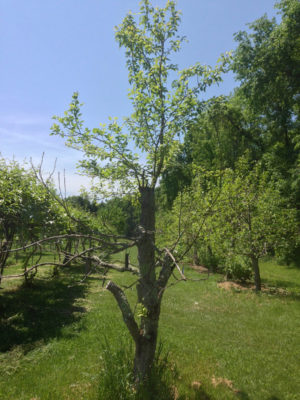
Look at one of my old pear trees, for instance. This tree might be called my “sample” or my “first cut” pear tree. When I hear tell of a pear variety that might be worth growing, I get a scion and graft it onto this tree. The scion bears quickly, in theory, at least, and, if it passes the “first cut,” perhaps it will warrant its own tree. There’s not enough time or space to put every Tom, Dick, and Harry of a pear variety on its own tree.
The tree now has about a dozen varieties of pear growing off various branches. That’s not weird, though. What is weird is that, right now, the top half of the tree is fully leafed out while limbs on the bottom half of the tree are leafless.
A disease? Doubtful. A disease killing that much of a tree at once would probably originate in the trunk or roots, in which case the whole tree or only the upper portion would be leafless. And anyway, those leafless limbs are not dead. Cutting beneath the bark reveals living, green tissue.
My hypothesis — a weak one — is that the cold snap in spring, where temperatures in the ‘teens followed a spate of temperatures in the 70’s, is the culprit. Warm temperatures in late winter and spring cause plants to rapidly awaken and lose the cold-hardiness they maintained through the coldest parts of winter. The pears seemed quite awake when that cold spell struck.
But why was only the bottom portion of the tree affected? (Here’s the weakness in my hypothesis.) Windless, clear nights, such as during spring’s cold snap, bring a temperature inversion. Under such conditions, denser cold air can settle down near ground level. Even a few feet of elevation can make a difference, one that’s evident when riding a bicycle or motorcycle on a clear summer night on rolling terrain.
So maybe the bottom half of the pear tree experienced temperatures just below the tipping point where enough damage occurred to delay leafing out.
Other Pear Trees, Still Whole
No other plants, including other pear trees, experienced this bifurcation. Then again, the “sample” pear is all by itself where the microclimate might be slightly different.
During that cold snap, the other pears were quite awake, seemingly just about ready to spread their blossoms. I was braced for a total crop loss. Weirdly, the trees went on to blossom just fine and now have what’s shaping up to be a decent load of fruit on them.
Seedling Troubles
More weirdness: Every season I sow vegetable seeds according to a schedule I’ve developed over the years. I sow the seeds in mini-furrows in flats of potting soil or potting soil topped with a mix of peat moss and perlite. Every season I make my own potting soil from a mix of equal parts peat moss, perlite, compost, and garden soil, with everything sifted together through half-inch mesh hardware cloth.
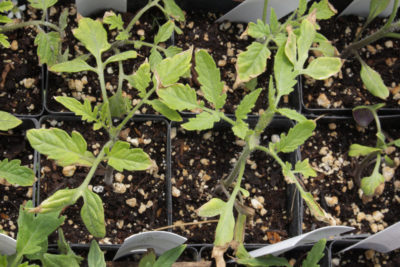 And every season I’ve had sturdy, lush green transplants to set out over the past few weeks. Not this season. Too many of the transplants are stunted, with flaccid leaves that are not uniformly lush green. Some have slight, interveinal yellowing of oldest leaves, some have slight reddening of veins, hinting, respectively, at insufficient nitrogen and phosphorus uptake .
And every season I’ve had sturdy, lush green transplants to set out over the past few weeks. Not this season. Too many of the transplants are stunted, with flaccid leaves that are not uniformly lush green. Some have slight, interveinal yellowing of oldest leaves, some have slight reddening of veins, hinting, respectively, at insufficient nitrogen and phosphorus uptake .
As usual, the weather could be blamed. Those auspicious, sunny days of late winter gave way to a long period of overcast days. Rain or not is not the issue because seedlings were in the greenhouse, watered as needed. Overwatered? Underwatered? Cool greenhouse temperatures could limit root growth, in turn limiting uptake of nutrients even if they are in the soil.
The potting soil could be the culprit. Although ingredients of my mix are always proportionately the same, the compost isn’t exactly the same from year to year. Same goes for the “garden soil” that goes into the mix. I scrape it up from various places around the yard: the bottom of a finished compost bin, from my catch-all extra soil bin, from top layers of a pond I’m occasionally hand-digging.
A couple of other gardeners and farmers have concurred with their seedlings’ poor growth this year. Perhaps it was the weather? Do you want to weigh in?
And the Winner Is . . .
Very few people offered hypotheses on why only one limb of my plum tree was in bloom. Neither the weather nor any other environmental condition was to blame. In fact, I had grafted the tree a few years ago to four different varieties in order to spread out the harvest date and offer a greater variety of plum flavors.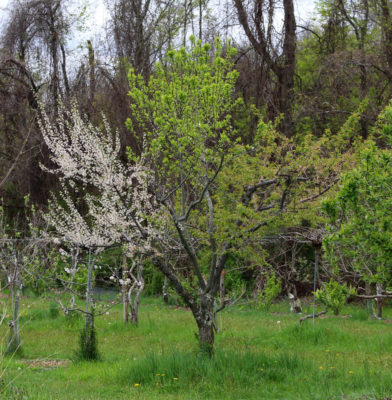
The bulk of the tree had already flowered.The one blooming branch was that of beach plum, the least reliable, smallest, and, to my taste, least flavorful of the lot. Perhaps I’ll graft that limb over to yet another variety.
Congratulations to Tom, tkjazzer@gmail.com, on winning a copy of my book Grow Fruit Naturally.

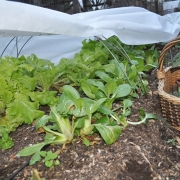
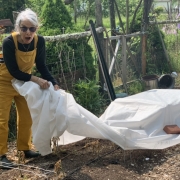
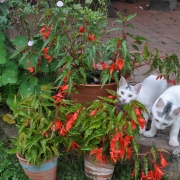

Thank you for offering a hypothesis to why the bottom half of the tree was effected, I have been puzzled about that in my yard. 2 tall Arborvitaes were fine until the arctic front came in, then the bottom half turned brown, top half is green as normal. It was worse with all the cypresses in the yard, only the top 1/4 stayed green. The very warm winter weather (with 70-80F in early March) followed by the arctic front did widespread destruction to many yews and cypresses in the area, some which have been in for decades. And zero blossoms on my peach tree. A combination of heavy snow and the cold temperatures resulted in thousands of daffodils heads drooping and they ended end not blooming. I was worried about my 2″ pea seedlings , but they did just fine in 15F, with mulch and heavy snow on top.
Very interesting post. I am in the southern hemisphere and this last Spring I bought some pears into the nursery. One of the double-grafted pears utterly failed to burst bud, equally surprising it was quite obviously NOT dead. The extremities of one of the grafts finally unfurled healthy leaves late Summer. I had assumed the early Spring flush and the very late full Winter break had reset the trees dormancy, the second graft being a later variety never having time to get over the reset. I am interested to hear other hypothesis or information on this phenomenon.